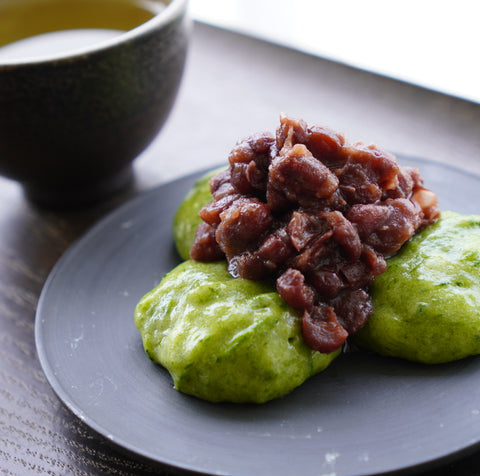山で見つけたもの
前回の記事「日本の春に山菜を採って調理する方法」で紹介したように、 4月のある日、山に行ってフキを採って調理しました。
そこで別の食用植物も見つけました。

よもぎ
それはヨモギ(蓬)です。ヨモギは日本全国に自生しています。一度見慣れてしまえば、どこにでも見かけるようになります。川辺、山、そして街中でも見つけることができます。
よもぎは古くから私たちの生活に寄り添ってきました。民間療法として、よもぎの葉は ヨモギは止血、喘息、体を温める効能として古くから用いられてきました。乾燥したヨモギの葉はお風呂に入れたり、お茶として飲んだりすることもできます。
また、よもぎはお灸の原料としてもぐさとしても有名です。

もぐさ
春のよもぎ料理を楽しむ
よもぎと言って一番思い出したのは、関西地方のよもぎ餅、関東地方の草餅で、よもぎの葉と餅粉から作られるもちもちした米菓子です。
祖母は毎年5月になると、よもぎ餅を作って送ってくれていました。よもぎの葉は春に摘み取られ、若くて柔らかい葉は料理によく合うので、よもぎ餅は春だけの特別な贈り物でした。祖父母からの小包の中によもぎ餅が入っているのを見ると、春が来たと感じ、春の特別なごちそうを楽しみました。 。それは特別な香りを持っていました。フレッシュでリラックス、そして青々とした香り。
よもぎ餅はどこのお店でも買えます。

いつもはお店で買っていますが、今回は自分でよもぎ餅を作ってみました!
よもぎ餅の作り方
摘んだ葉っぱを洗いました。

葉を茹でました。

真水に浸してふるいにかけた後、乳鉢と乳棒ですり潰しました。

同時に、上新粉(じょうしんこ)と砂糖と熱湯を混ぜて蒸しました。これで餅ができます。


それから餅とよもぎを挽いて混ぜました。


細かく切れば完成です。

作ったよもぎ餅です。なんて美しい緑色なんでしょう!あんこと一緒にいただきました。よもぎ餅とあんこ、そして緑茶、特に新茶(2021年春摘み)の組み合わせは最高です!
先日はきなこと一緒に食べました!こちらも美味しかったです。

よもぎ餅の味は、おばあちゃんのよもぎ餅を思い出させました。お店で売っているものよりも、手作りならではのおいしさと、より元気が出る味だと感じました。
来春またよもぎ餅を作るつもりです。
関連記事:
本日のおすすめ
この豆を使ってあんこを作ることができます。

『1分でわかるあんこの作り方』英語字幕付き
新茶(2021年春摘み茶)をお楽しみください!!
兼六松本茶園 新茶 - 限定品 - プレミアム特上新茶2021
静岡県島田市牧之原平野の霧山地区で、3代目茶農家の松本弘樹氏は約30の茶畑を経営しています。彼はユネスコ世界遺産にも登録されている「茶草場」という農耕技術を用いて茶葉を栽培しています。この農耕技術では、茶畑の周囲にササを植え、それを肥料として利用します。定期的に蒸すことで、バランスの取れた煎茶が生まれます。


